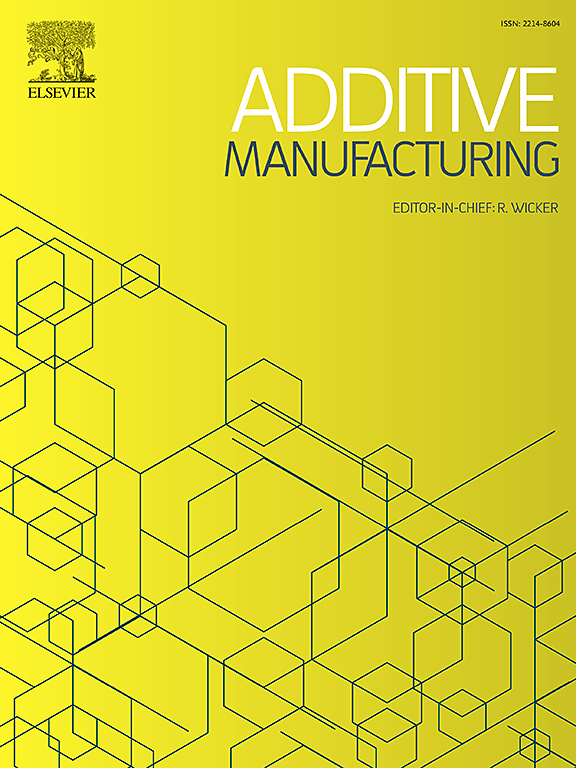薄增材制造连续纤维热固性复合材料的翘曲
IF 10.3
1区 工程技术
Q1 ENGINEERING, MANUFACTURING
引用次数: 0
摘要
薄型连续纤维热固性复合材料的增材制造(AM)可能会产生较大的各向异性残余应力,从而导致平面外形状变形或翘曲,限制了薄型结构的适用性。在本研究中,研究了薄 AM 层压板的翘曲与沉积纤维方向和微结构异质性的函数关系。实验结果与经典层压理论(Classical Lamination Theory,CLT)和微观结构信息层压理论(Microstructure-informed CLT)的预测结果进行了比较,前者假定沉积层是均匀的,后者则考虑了厚度方向的异质性。对于单向薄层板,在从最高固化温度(140°C)开始缓慢(0.3°C/分钟)无约束冷却时,在横向方向观察到弯曲。随着沉积层数(n)从 n = 1(κ = 8 m-1)增加到 n = 8(κ = 1 m-1),观察到的曲率(κ)的大小有所减小,与 CLT 预测的零曲率不符。通过光学横截面显微照片对通厚纤维体积分数的变化进行量化,并利用显微结构对 CLT 进行预测,预测范围从 κ = ∼ 0.6 m-1 (n = 8) 到 κ = 26 m-1 (n = 1)。对称堆叠的交叉层压板(0° 和 90°)的曲率接近零,与 CLT 预测一致,而不对称堆叠的交叉层压板则预测出较大的马鞍形曲率,但由于正交排列层之间的分层,并未完全观察到这种曲率。对于没有分层的薄 AM 热固性层压板(≤4 层,∼0.24 毫米/层),实验观察到的曲率值大致介于 CLT 预测值和微观结构信息 CLT 预测值之间。本文章由计算机程序翻译,如有差异,请以英文原文为准。
Warpage of thin additively manufactured continuous fiber thermoset composites
Additive manufacturing (AM) of thin continuous fiber thermoset composites can have large and anisotropic residual stresses that result in out of plane shape distortion, or warpage, and limits applicability to thin structures. In this study, the warpage of thin AM laminates was investigated as a function of deposited fiber direction and microstructure heterogeneity. The experimental results were compared with predictions made by Classical Lamination Theory (CLT), which assumed homogeneous deposited layers, and microstructure-informed CLT, which accounted for heterogeneity in the thickness direction. For thin unidirectional laminates, a curvature was observed in the transverse direction upon slow (0.3 °C/min) unconstrained cooling from the maximum curing temperature (140°C). Magnitudes of the observed curvatures () decreased as the number of deposited layers (n) increased from n = 1 ( = 8 m−1) to n = 8 ( = 1 m−1) and did not match the CLT prediction of zero curvature. The variation in through-thickness fiber volume fraction was quantified by optical cross-section micrographs and used to make microstructure-informed CLT predictions which ranged from = ∼0.6 m−1 (n = 8) to = 26 m−1 (n = 1). While the curvature of the symmetrically stacked cross-ply laminates (0° and 90°) had near zero curvature and agreed with CLT predictions, the asymmetrically stacked cross-ply laminates predicted a large saddle-like curvature that was not fully observed due to delamination between orthogonally aligned layers. For thin (≤4 layers, ∼0.24 mm/layer) AM thermosetting laminates without delamination, the experimentally observed curvature values were roughly bounded between predictions made by CLT and by microstructure-informed CLT.
求助全文
通过发布文献求助,成功后即可免费获取论文全文。
去求助
来源期刊

Additive manufacturing
Materials Science-General Materials Science
CiteScore
19.80
自引率
12.70%
发文量
648
审稿时长
35 days
期刊介绍:
Additive Manufacturing stands as a peer-reviewed journal dedicated to delivering high-quality research papers and reviews in the field of additive manufacturing, serving both academia and industry leaders. The journal's objective is to recognize the innovative essence of additive manufacturing and its diverse applications, providing a comprehensive overview of current developments and future prospects.
The transformative potential of additive manufacturing technologies in product design and manufacturing is poised to disrupt traditional approaches. In response to this paradigm shift, a distinctive and comprehensive publication outlet was essential. Additive Manufacturing fulfills this need, offering a platform for engineers, materials scientists, and practitioners across academia and various industries to document and share innovations in these evolving technologies.
 求助内容:
求助内容: 应助结果提醒方式:
应助结果提醒方式:


